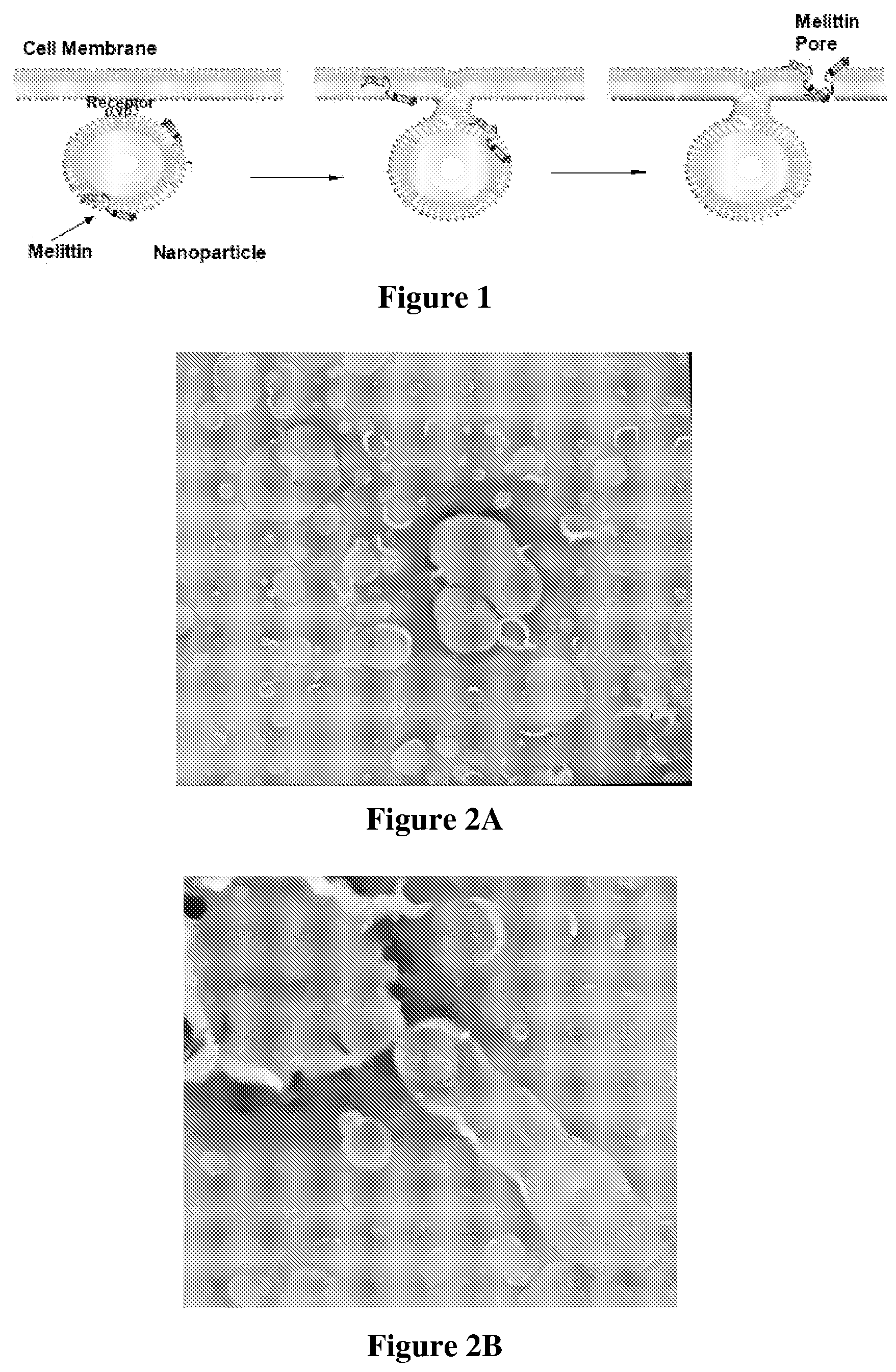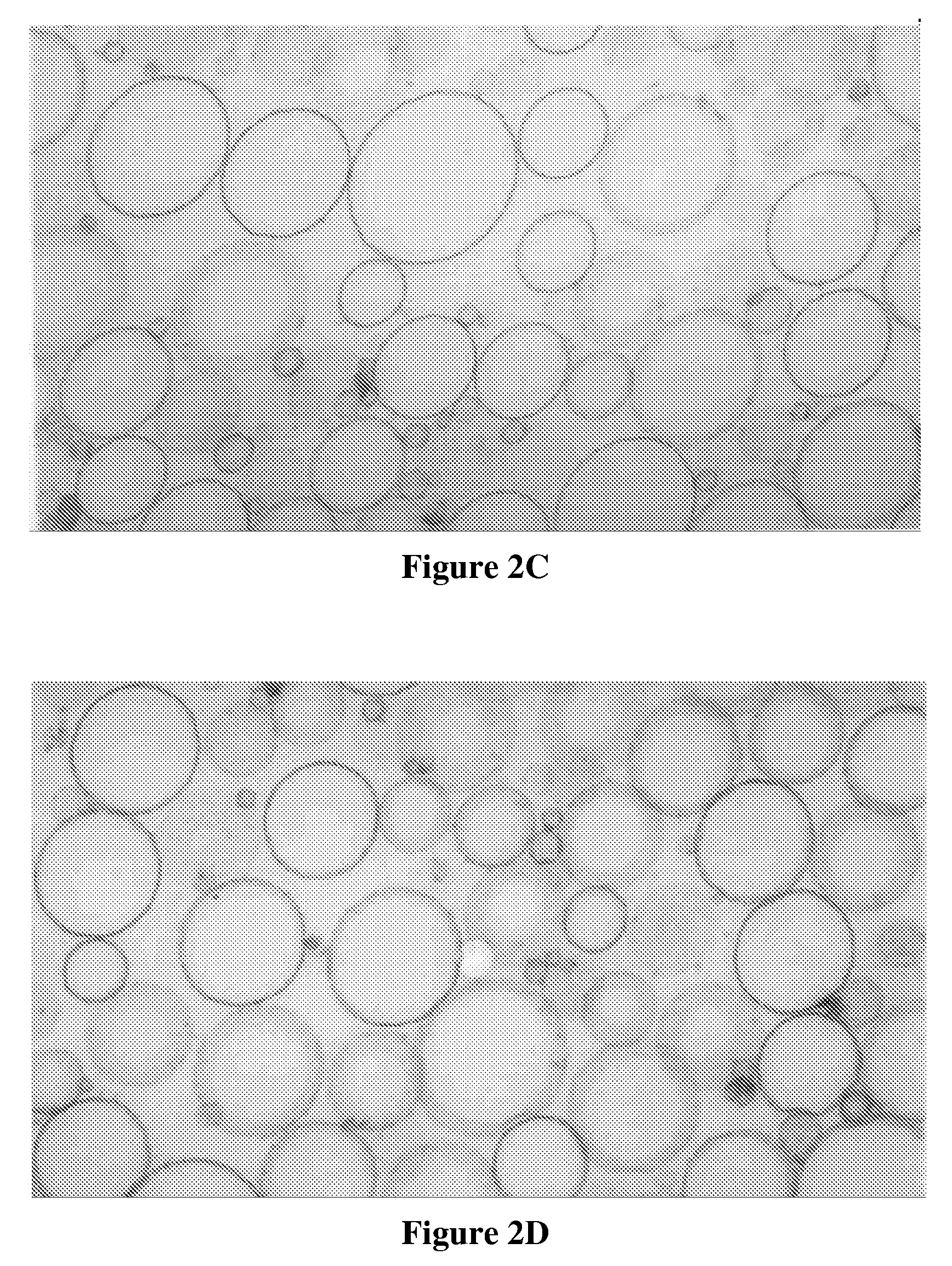Nanoparticle delivery systems for membrane-integrating peptides
a technology of membrane integration and nanoparticles, applied in the direction of peptide/protein ingredients, drug compositions, antibacterial agents, etc., can solve the problems of peptides presenting particular problems, cell death, and general inapplicability, and achieve the effect of increasing ldh release and reducing cell proliferation
- Summary
- Abstract
- Description
- Claims
- Application Information
AI Technical Summary
Benefits of technology
Problems solved by technology
Method used
Image
Examples
example 1
Preparation of Perfluorocarbon Nanoparticles
[0056]Perfluorocarbon nanoparticles were synthesized as described by Winter, P. M., et al., Arterioscler. Thromb. Vasc. Biol. (2006) 26:2103-2109. Briefly, a lipid surfactant co-mixture of egg lecithin (98 mol %) and dipalmitoyl-phosphatidylethanolamine (DPPE) 2 mol % (Avanti Polar Lipids, Piscataway, N.J.) was dissolved in chloroform, evaporated under reduced pressure, dried in a 50° C. vacuum oven and dispersed into water by sonication. The suspension was combined with either perfluoro-octylbromide (PFOB), or perfluoro-15-crown ether (CE) (Gateway Specialty Chemicals, St. Peters, Mo.), and distilled deionized water and continuously processed at 20,000 lbf / in2 for 4 min with an S110 Microfluidics emulsifier (Microfluidics, Newton, Mass.). αvβ3-integrin targeted nanoparticles were made by incorporating 0.1 mole % peptidomimetic vitronectin antagonist conjugated to polyethylene glycol (PEG)2000-phosphatidylethanolamine (Avanti Polar Lipids,...
example 2
Incorporation of Melittin onto Nanoparticles
[0058]Melittin-loaded nanoparticles were formulated by mixing known amounts of melittin to perfluorocarbon nanoparticles. Pure melittin peptide material produced by solid-state peptide synthesis was obtained from Dr. Robert Mecham at Washington University Medical School, Department of Cell Biology and Physiology. The melittin was dissolved in 100 mM KCl (pH 7, mM HEPES) at 0.1 mM and 2-20 mL was added to 50 μl of nanoparticle suspension with mixing. After incubation at room temperature for 10 min, the nanoparticles were washed twice by centrifugation (100 g, 10 min) to remove the unbound melittin. The melittin in the supernatant was quantified by measuring the tryptophan fluorescence (described below). Depending on the amount of melittin added, the melittin-loaded nanoparticles yielded molar lipid / melittin ratios ranging from 1,000 to 40.
example 3
Characterization of Melittin Nano-Emulsions
A. Size Distribution and Zeta Potential
[0059]The size distribution of melittin-loaded nanoparticles was determined by photon correlation spectroscopy (PCS) on a Malvern Zetasizer 3000HS (Malvern Instruments, Malvern, UK). Zeta potential (ζ) values for the nanoparticles were determined with a Brookhaven Instruments PALS Zeta Potential Analyzer (Brookhaven Instruments). Data were acquired in the phase-analysis light scattering (PALS) mode following solution equilibration at 25° C. The Smoluchowski approximation was employed to calculate 4 from the measured nanoparticle electrophoretic mobility (μ):
μ=∈·ζ·(1.5) / η
where ∈ and η are the dielectric constant and the absolute viscosity of the medium, respectively.
[0060]The melittin-carrying nanoparticles exhibited a mean diameter of 358.8 nm (polydispersity index 0.011) when measured at an angle of 90 degrees using the Malvern Particle Size Analyzer. The zeta potential (ζ) was −31.5 mV. Measurements ...
PUM
| Property | Measurement | Unit |
|---|---|---|
| temperature | aaaaa | aaaaa |
| pH | aaaaa | aaaaa |
| hydrophobic | aaaaa | aaaaa |
Abstract
Description
Claims
Application Information
 Login to View More
Login to View More - R&D
- Intellectual Property
- Life Sciences
- Materials
- Tech Scout
- Unparalleled Data Quality
- Higher Quality Content
- 60% Fewer Hallucinations
Browse by: Latest US Patents, China's latest patents, Technical Efficacy Thesaurus, Application Domain, Technology Topic, Popular Technical Reports.
© 2025 PatSnap. All rights reserved.Legal|Privacy policy|Modern Slavery Act Transparency Statement|Sitemap|About US| Contact US: help@patsnap.com



